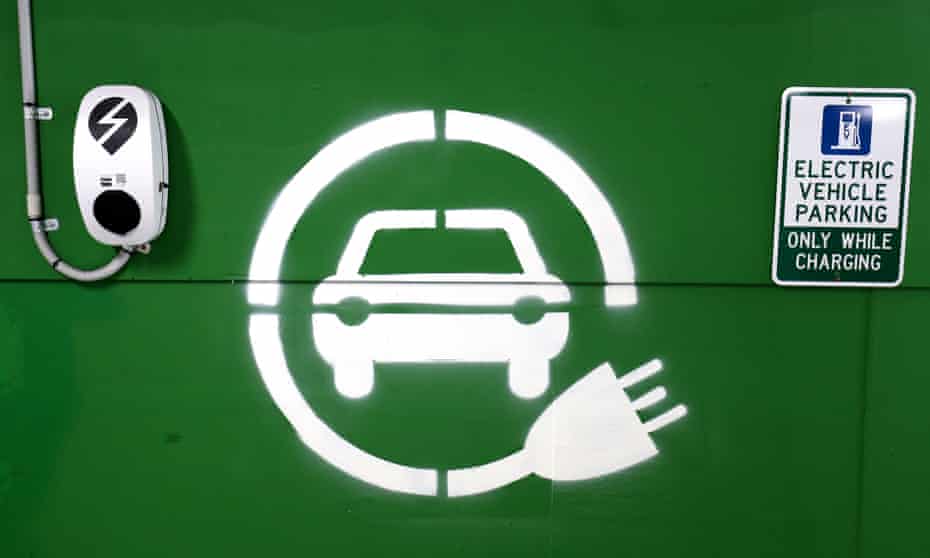Electric vehicles are too big an opportunity to miss. Here’s what Australia should be doing
The true Australian Way would be to harness clean transport technology to lower costs, improve the air we breathe and create new jobs, all while supporting net zero emissions

The Morrison government on Tuesday announced its future fuels and vehicles strategy. Overall it’s a missed opportunity.
Electric vehicles should not be seen as an environmental issue. The transition to electric vehicles is a major economic opportunity for Australia – if we can get coherent and strategic national policy to capitalise on the benefits of this transformative change.
Australians are estimated to spend more than $30bn each year on imported fuel. This means that there are billions in the hard-earned incomes of Australian households and businesses flowing out of our country every single year. By switching to electric vehicles, our transport system can be at least 70% cheaper to power – that means saving literally hundreds of billions in fuel costs over the next 10 to 20 years. These savings can instead be spent elsewhere in the local economy or to pay off debt. Importantly, the remaining spending on transport fuel for electric vehicles would be directed towards Australian-made energy. This is something you would expect even Scott Morrison and Angus Taylor could get behind.
But alas no, instead, when you next go to the fuel pump, and pay $1.70, $1.80, maybe even $2.00 a litre, paying for foreign fuel, and supporting jobs overseas, remember that this is because our government does not have an adequate plan to help you make the switch to an electric vehicle powered using Australian-made energy, supporting Australian jobs. For which, by the way, you would only pay the equivalent of $0.20-0.40 a litre.
What about fuel excise? Shouldn’t we be worried about losing this revenue? Despite the scaremongering of some interest groups, the reality is that the cost savings from the transition to electric vehicles far outweigh any loss of fuel excise over the coming decades. We need to have a more holistic approach to reforming road taxes that discourages polluting vehicles, and importantly, addresses road congestion.
Then there is the issue of health. Currently our petrol and diesel-powered transport system is flooding our communities with carcinogenic fumes. Think about where most schools, childcare centres, nursing homes and hospitals are located – on main roads, surrounded by our high-polluting vehicles. The government’s own estimates suggest the country could save $200m in public health costs by 2035 if we achieve 30% EV sales by 2030. That’s a start, but to align with net zero by 2050 we need to be at more than 50% EV sales by 2030 – and if we could get the policy we so desperately need to achieve this, the public health cost savings would be even greater.
The Australian Conservation Foundation recently found that maintaining our current approach to managing transport emissions could cost up $865bn between 2022 and 2050, attributed to: air pollution ($488bn), greenhouse gas emissions ($205bn), noise ($95bn), and water pollution ($76bn). In contrast, by adopting more ambitious zero emission transport policies, Australia could reduce these costs by up to $492bn.
Finally there are the major job opportunities that will flow from a global transition to electric vehicles. While it is great that we finally have a critical minerals strategy for Australia, we need to provide certainty so investment can be directed towards ramping up the lithium, nickel, cobalt, copper and other minerals the world needs to make the switch.
No matter which way you look at it, electric vehicles have been found to deliver a net benefit to economies the world over.
So what should our government be doing to ensure we don’t miss out?
Supporting electric vehicles is not rocket science. There just happens to be a world of countries that are ahead of us on this transition and have shown us what is possible.
To start with, in line with achieving net zero emissions by 2050, the national electric vehicle strategy that Australia deserves must set clear targets of at least 50% of new car sales being electric by 2030, and 100% by 2035.
This translates to selling 1 million electric vehicles by 2027, and at least 2.5 million by 2030. It is a massive increase from the 30,000 or so sold over the past five years and 50% higher than what is forecast in the government’s strategy.
Until we reach this initial target of 1 million electric vehicles, Australian governments need to introduce:
-
Electric vehicle sales mandates to increase the supply of vehicles into the country, and penalise carmakers that miss these targets.
-
Both the federal and state governments should agree to make electric vehicles exempt from GST (as done in Norway). State governments should also make electric vehicles exempt from stamp duty and annual registration fees.
-
To genuinely support fleet adoption, electric vehicles should be made exempt from fringe benefits tax. This policy could be funded by the reinstatement of the car depreciation limit which currently acts as a subsidy for petrol/diesel vehicles with a load carrying capacity of greater than one tonne.
-
Commit sufficient funding to support the rollout of one public charging point for every 10 electric vehicles – that’s 100,000 chargers by 2027.
-
Penalise those states that go it alone on electric vehicle road taxes, unfairly locking rural and regional Australians out of the electric vehicle market. Instead, roads should be funded by pricing congestion in our cities, which is on track to cost almost $40bn by 2031.
The true Australian Way would be to harness a clean transport technology that can lower transport and energy costs for everyone using Australian-made energy, improving the air we breathe, and creating new jobs, all while supporting net zero emissions by 2050 – at the latest.